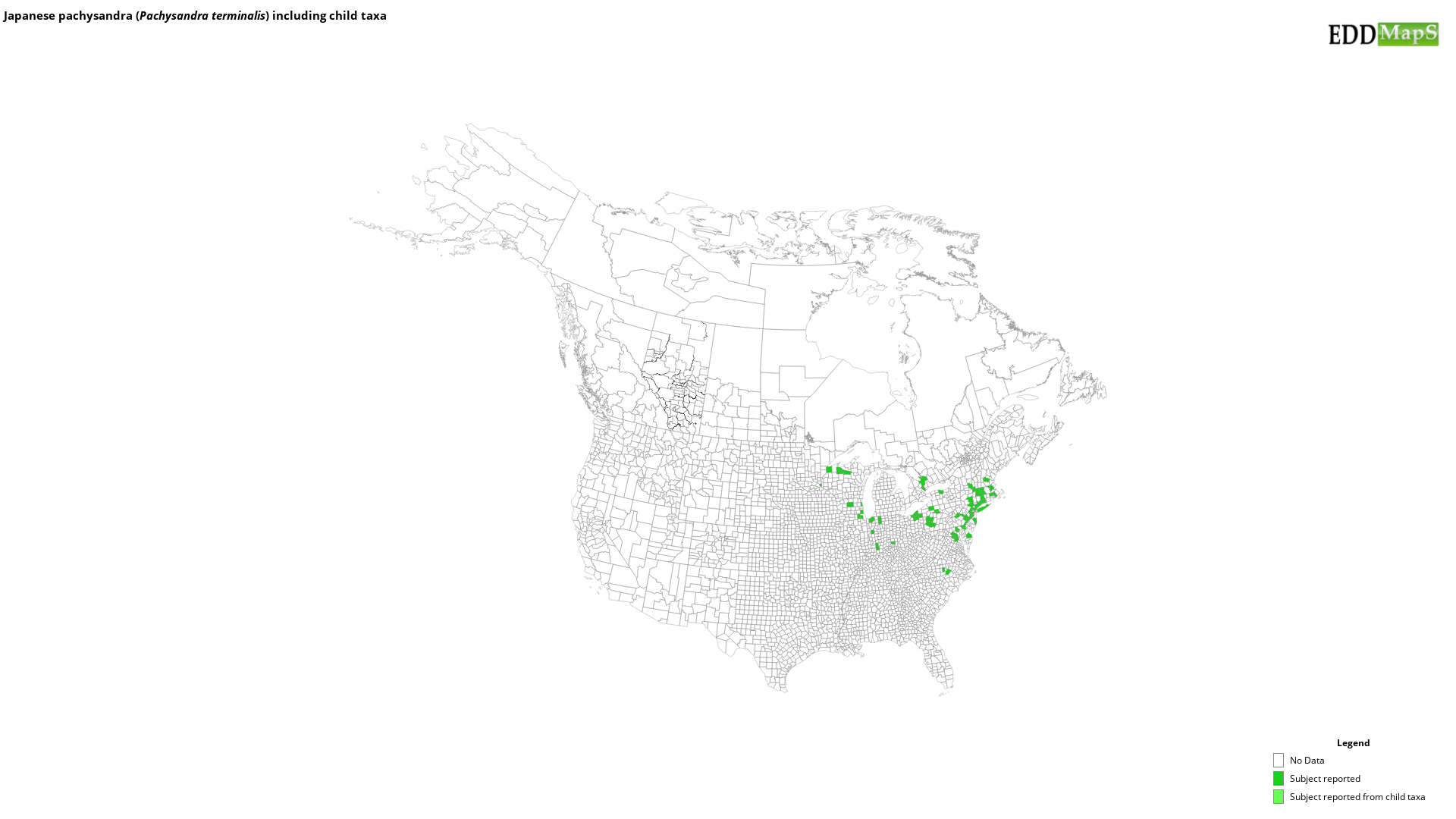Japanese pachysandra
(Pachysandra terminalis)
This species is Introduced in the United States
ORIGIN: temperate Asia
GROWTH TRAITS: Evergreen shrub growing 4-10" (5-25 cm) tall from a stoloniferous root system. Underground and aboveground runners root at nodes and send up stems, eventually forming dense mats. Leaves are sometimes alternate but are frequently whorled at branch tips and are ovate to elliptical to obovate and coarsely toothed at their tips. Most leaves are 2-4" (5-10 cm) long, waxy, and a rich dark, glossy green, but some cultivars are variegated white and green. Foliage typically remains green throughout winter. Flowers appear in erect clusters 1-2" (2.5-5 cm) long at branch tips in early spring. Flowers are 0.5" (1.3 cm) long with white, bristle-like petals and maroon-tipped stamens. Fruits are white, berry-like, and 0.5" (1.3 cm) long, but are rarely produced in North America.
REPRODUCTION: Spreads primarily via stolons.
HABITAT: Grows in a variety of soils but does best in well-drained soils rich in organic matter and in partial to full shade. It can be found invading forest understories, often spreading from locations where it was intentionally planted.
LOOK-ALIKES: Several native and exotic understory groundcover species are present in North America and resemble Japanese pachysandra with their evergreen, waxy leaves and short height. The combination of whorled, obovate leaves toothed at their tips, clusters of small, bristly-looking white flowers, and typical lack of fruit help differentiate this species from most potential look-alikes. The native Allegheny spurge (Pachysandra procumbens) has similar bristly-looking flowers and leaves toothed at their tips. Allegheny spurge differs by having leaves being either deciduous or more tattered over winter, longer flower clusters, and flowers that are pale pink instead of creamy white.
CITATIONS:
Rawlins, K.A., R.L. Winston, C.T. Bargeron, D.J. Moorhead, and R. Carroll. 2018. New Invaders of the Northeast and Northcentral United States. USDA Forest Service, Forest Health Assessment and Applied Sciences Team, Morgantown, West Virginia. FHTET-2017-04. Retrieved from https://bugwoodcloud.org/resource/pdf/FHTET-2017-04_New%20Invaders_NE.pdf
GROWTH TRAITS: Evergreen shrub growing 4-10" (5-25 cm) tall from a stoloniferous root system. Underground and aboveground runners root at nodes and send up stems, eventually forming dense mats. Leaves are sometimes alternate but are frequently whorled at branch tips and are ovate to elliptical to obovate and coarsely toothed at their tips. Most leaves are 2-4" (5-10 cm) long, waxy, and a rich dark, glossy green, but some cultivars are variegated white and green. Foliage typically remains green throughout winter. Flowers appear in erect clusters 1-2" (2.5-5 cm) long at branch tips in early spring. Flowers are 0.5" (1.3 cm) long with white, bristle-like petals and maroon-tipped stamens. Fruits are white, berry-like, and 0.5" (1.3 cm) long, but are rarely produced in North America.
REPRODUCTION: Spreads primarily via stolons.
HABITAT: Grows in a variety of soils but does best in well-drained soils rich in organic matter and in partial to full shade. It can be found invading forest understories, often spreading from locations where it was intentionally planted.
LOOK-ALIKES: Several native and exotic understory groundcover species are present in North America and resemble Japanese pachysandra with their evergreen, waxy leaves and short height. The combination of whorled, obovate leaves toothed at their tips, clusters of small, bristly-looking white flowers, and typical lack of fruit help differentiate this species from most potential look-alikes. The native Allegheny spurge (Pachysandra procumbens) has similar bristly-looking flowers and leaves toothed at their tips. Allegheny spurge differs by having leaves being either deciduous or more tattered over winter, longer flower clusters, and flowers that are pale pink instead of creamy white.
CITATIONS:
Rawlins, K.A., R.L. Winston, C.T. Bargeron, D.J. Moorhead, and R. Carroll. 2018. New Invaders of the Northeast and Northcentral United States. USDA Forest Service, Forest Health Assessment and Applied Sciences Team, Morgantown, West Virginia. FHTET-2017-04. Retrieved from https://bugwoodcloud.org/resource/pdf/FHTET-2017-04_New%20Invaders_NE.pdf
Selected Images
Maps
EDDMapS Distribution - This map is incomplete and is based only on current site and county level reports made by experts, herbaria, and literature. For more information, visit www.eddmaps.org
State Lists - This map identifies those states that have this species on their invasive species list or law.
Invasive Listing Sources
- Jil M. Swearingen, Survey of invasive plants occurring on National Park Service lands, 2000-2007
- John Randall, The Nature Conservancy, Survey of TNC Preserves, 1995.
- National Park Service, Mid-Atlantic Exotic Plant Management Team Invasive Plant List
- New Invaders of the Northeast and Northcentral
- Non-Native Invasive Plants of Arlington County, Virginia
- Pennsylvania Department of Conservation and Natural Resources Invasive Plants
- WeedUS - Database of Plants Invading Natural Areas in the United States
Taxonomic Rank
| Domain: Eukarya |
| Kingdom: Plantae |
| Phylum: Magnoliophyta |
| Class: Magnoliopsida |
| Superorder: Buxanae |
| Order: Buxales |
| Family: Buxaceae |
| Genus: Pachysandra |
| Pachysandra terminalis |
References
Common Name Reference: USDA, NRCS. 2010. The PLANTS Database. National Plant Data Center, Baton Rouge, LA, USA.
Scientific Name Reference: USDA, NRCS. 2010. The PLANTS Database. National Plant Data Center, Baton Rouge, LA, USA.


